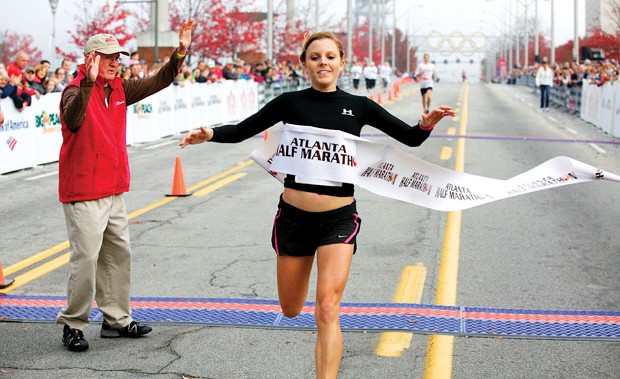A runner crosses the finish line of the Atlanta Half-Marathon. Photo: Atlanta Track Club
The half doesn’t receive half the attention of the marathon, but it’s possibly the perfect distance, particularly for new runners. Running 13.1 is doable, but still a formidable challenge. Here’s your guide to taking your first strides as a “real” runner on your way to completing your first half marathon.
Your Training Plan
You should have one goal in mind for your first half marathon: finishing the race and enjoying it. “Only focus on building endurance when training for your first half,” says Francesca Conte, a professional runner and co-owner of Charlottesville Running Company. “Forget about speed work and improving your time until the next race. For now, just build a solid endurance base.” Conte designed a simple eight-week training program tailored for beginners who need to build endurance, based on four days a week of running:
Day 1: Base run (base pace is your normal pace) of 40 minutes to one hour.
Day 2:Long run at simulated race pace. Begin each run with a one mile warm up. Run at your expected race pace. Begin with a three-mile run and work up to an eight-mile run by increasing one mile a week.
Day 3: Recovery trail run (about 30-40 seconds/mile slower than your base pace) of 40 minutes to one hour. Trails are a great way to gain strength and stay cooler in the summer. Cross training, like biking or swimming, is also appropriate for this day.
Day 4:Long run: begin at four miles and increase one mile per week up to 12 miles for your last long run.
Taper: Drop the mileage for at least two weeks before your race.
Drink and Be Merry
It’s race day: you’re nervous, psyched, scared and you have to pee every five minutes leading up to the gunshot. We asked Tina Klein, trainer for the Atlanta Half Marathon, to detail how much you should be drinking before, during, and after your race.
Drink before you’re thirsty Thirst is an unreliable way of knowing when you need to hydrate because you are usually 2 – 3 percent dehydrated before you actually become thirsty. Hydrate at least every 20 minutes. You’ll also want to take in some electrolytes.
Avoid caffeine This can dehydrate you, unless you have been practicing drinking it prior to your runs. As a rule of thumb, for every one-cup of caffeine, you’ll want to flush out your system with four cups of water.
Drink beforehand Be sure to drink 14 – 20 ounces two hours before the race. This will allow your body to absorb the maximum amount and pass the excess prior to the start.
Replace afterward After your run, you’ll need to replace the water you lost. Weigh yourself one hour prior to your workout and immediately after you’ve finished. A rule of thumb is to drink 1.5 ounces of water for each ounce you lose (1 pound = 16 ounces).








